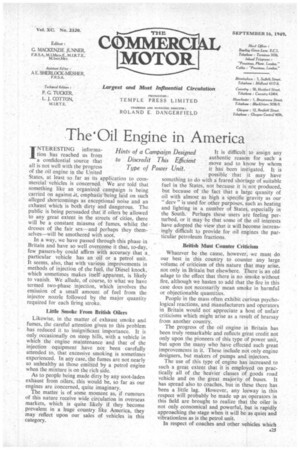• The40i1 Engine in America
Page 27

Page 28

If you've noticed an error in this article please click here to report it so we can fix it.
Hints of a Campaign Designed to Discredit This Efficient Type of Power Unit.
INTERESTING information has reached us from a confidential source that all is not well with the progress of the oil engine in the United States, at least so far as its application to commercial vehicles is concerned. We are• told that something like an organized campaign is being carried on against emphasis being laid on such alleged shortcomings as exceptional noise and an exhaust which is both dirty and dangerous. The public is being persuaded that if oilers be allowed to any great extent in the streets of• cities, there will be a constant miasma of fumes, whilst the dresses of the fair sex—and perhaps they themselves—will be smothered with soot.
In a way, we have passed through this phase in Britain and have so well overcome it that, to-day, • few passers-by could affirm with accuracy that a_ particular vehicle has an oil or a petrol unit. It seems, also, that with various improvements in methods of injection of the fuel, the Diesel knock, which sometimes makes itself apparent, is likely to vanish. We allude, of course, to what we have termed two-phase injection, which involves the emission of a small amount of fuel from the injector nozzle followed by the major quantity required for each firing stroke.
Little Smoke From British Oilers Likewise, in the matter of exhaust smoke and fumes, the careful attention given to this problem has reduced it to insignificant importance. It is only occasionally on steep hills, with a vehicle in which the engine maintenance and that of the injection equipment have not been carefully attended to, that excessive smoking is sometimes experienced. In any case, the fumes are not nearly so unhealthy as those emitted by a petrol engine when the mixture is on the rich side.
As to people being made dirty by any soot-laden exhaust from oilers, this would be, so far as our engines are concerned, quite imaginary.
The matter is of some moment as, if rumours of this nature receive wide circulation in overseas markets, which is quite likely if they become prevalent in a huge country like America, they may reflect upon our sales of vehicles in this category. It is difficult to assign any authentic reason for such a move and to know by whom it has been instigated. It is possible that it may have something to do with a feared shortage of suitable fuel in the States, not because it is riot produced, but because of the fact that a large quanity of oil with almost as high a Specific gravity as our " dery " is used for other purposes, such as heating and lighting in a number of States, especially in the South. Perhaps these users are feeling perturbed, or it may be that some of the oil interests have adopted the view that it will become increasingly difficult to provide for oil engines the particular petroleum fractions.
British Must Counter Criticism Whatever be the cause, however, we must do our best in this country to counter any large volume, of criticism of this nature that may arise, not only in Britain but elsewhere. There is an old adage to the effect that there is no smoke without fire, although we hasten to add that the fire in this case does not necessarily mean smoke in harmful or objectionable quantities. tti People in the mass often exhibit c nous psychological reactions, and manufacturers nd operators in Britain would not appreciate a iost of unfair criticisms which might arise as a res It of hearsay from another country.
The progress of the oil engine ilk Britain has been truly remarkable and reflects great credit not only upon the pioneers of this type of power unit, but upon the many who have effected such great improvements in it. These include not only engine designers, but makers of pumps and injectors.
The use of this type of engine has increased to such a great extent that it is employed on practically all of the heavier classes of goods road vehicle and on the great majority of buses. It has spread also to coaches, but in these there has been a little lag. However, any leeway in this respect will probably be made up as operators in this field are brought to realize that the oiler is not only economical and powerful, but is rapidly approaching the stage when it will be as quiet and vibrationless as is the petrol unit.
In respect of coaches and other vehicles which A25 do not as a general rule run large yearly mileages. there is. of course; the adverse factor of higher initial outlay. Even it the fuel and maintenance costs be reduced these savings will not be felt until a certain total mileage has been attained. With coaches, too, the maximum speed obtainable is more important, and an engin.e governed to revolutions• below those normally available in a petrol unit may not be appreciated. However, progress is also being made in this direction and the speed distinction between the two types is becoming smaller.




















































































